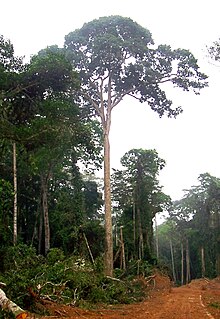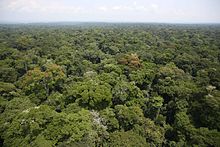Congolian rainforests
| Congolian rainforests | |
|---|---|
 Congolian rainforest ecoregions: 2. Atlantic Equatorial coastal forests, 6. Central Congolian lowland forests 7. Eastern Congolian swamp forests, 8. Western Congolian swamp forests, 9. Northeastern Congolian forests, 15. Northwestern Congolian lowland forests | |
| Ecology | |
| Realm | Afrotropical |
| Biome | Tropical and subtropical moist broadleaf forests |
| Geography | |
| Countries | |

The Congolian rainforests are a broad belt of lowland tropical moist broadleaf forests which extend across the basin of the Congo River and its tributaries in Central Africa.
Geography[]
The Congolian forests cover southeastern Cameroon, Gabon, the Republic of the Congo, the northern and central Democratic Republic of the Congo, and portions of southern and central Africa.
Ecology[]
The Congolian rainforest is the world's second-largest tropical forest, spans six countries, and contains a quarter of the world's remaining tropical forest.[1] With annual forest loss of 0.3% during the 2000s,[2] the region has the lowest deforestation rate of any major tropical forest zone.[3]
To the north, south, and southwest, the forests transition to drier forest-savanna mosaic, a mosaic of drier forests, savannas, and grasslands.[4] To the west, the Congolian forests transition to the coastal Lower Guinean forests, which extend from southwestern Cameroon into southern Nigeria and Benin; these forests zones share many similarities and are sometimes known as the Lower Guinean-Congolian forests. To the east, the lowland Congolian forests transition to the highland Albertine Rift montane forests, which cover the mountains lining the Albertine Rift, a branch of the East African Rift system. The Congolian Forests are a global 200 ecoregion.

The Congo is the least biodiverse tropical region in the world, falling behind the Amazon and Southeast Asia. However, its plant and animal life is still more rich and varied than most other places on Earth. Chimpanzees, bonobos and gorillas are found here.
Ecoregions[]
The World Wide Fund for Nature divides the Congolian forests into six distinct ecoregions:
- Atlantic Equatorial coastal forests (Cameroon, Equatorial Guinea, Gabon, Republic of the Congo, Angola, Democratic Republic of the Congo)
- Northwestern Congolian lowland forests (Cameroon, Central African Republic, Gabon, Republic of Congo)
- Western Congolian swamp forests (Republic of the Congo, Democratic Republic of the Congo)
- Eastern Congolian swamp forests (Democratic Republic of the Congo)
- Central Congolian lowland forests (Democratic Republic of the Congo)
- Northeastern Congolian lowland forests (Democratic Republic of the Congo, Central African Republic)Boats on the Lomami River, Democratic Republic of the Congo.
See also[]
- Lower Guinean forests
- Flora of West-Central Tropical Africa
References[]
- ^ "Congo Basin Forest Partnership". USAID. Archived from the original on 2008-05-08. Retrieved 2008-05-06.
- ^ Mayaux, P.; Pekel, J. F.; Desclée, B.; Donnay, F.; Lupi, A.; Achard, F.; Clerici, M.; Bodart, C.; Brink, A.; Nasi, R.; Belward, A. (2013). "Mayaux et al 2013". Philosophical Transactions of the Royal Society of London. Series B, Biological Sciences. Philosophical Transactions of the Royal Society B. 368 (1625): 20120300. doi:10.1098/rstb.2012.0300. PMC 3720022. PMID 23878331.
- ^ "Deforestation in the Congo Rainforest". Mongabay.
- ^ Linder, H. Peter, Helen M. de Klerk Julia Born et al. (2012). "The partitioning of Africa: statistically defined biogeographical regions in sub‐Saharan Africa". Journal of Biogeography Volume 39, Issue 7 May 2012. [1]
External links[]
- https://web.archive.org/web/20120308120322/http://www.whrc.org/mapping/pantropical/carbonmap2000.html
- Congo Basin Ecoregions, Yale School of Forestry and Environmental Studies
- The Congo Rainforest
- Afrotropical ecoregions
- Rainforests of Africa
- Congolian forests
- Ecoregions of Cameroon
- Ecoregions of Gabon
- Ecoregions of the Central African Republic
- Ecoregions of the Democratic Republic of the Congo
- Ecoregions of the Republic of the Congo
- Flora of West-Central Tropical Africa
- Flora of Cameroon
- Flora of Gabon
- Flora of the Central African Republic
- Flora of the Democratic Republic of the Congo
- Flora of the Republic of the Congo
